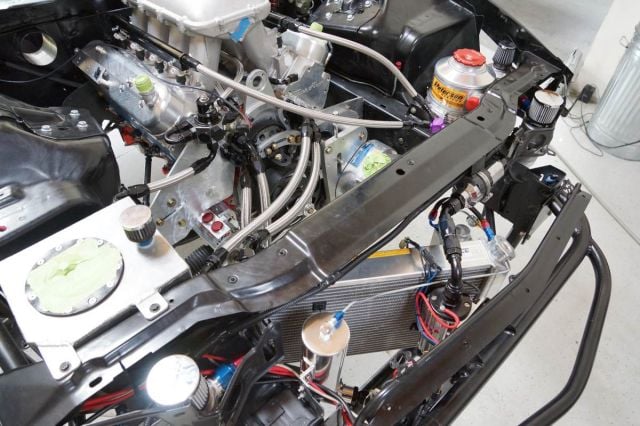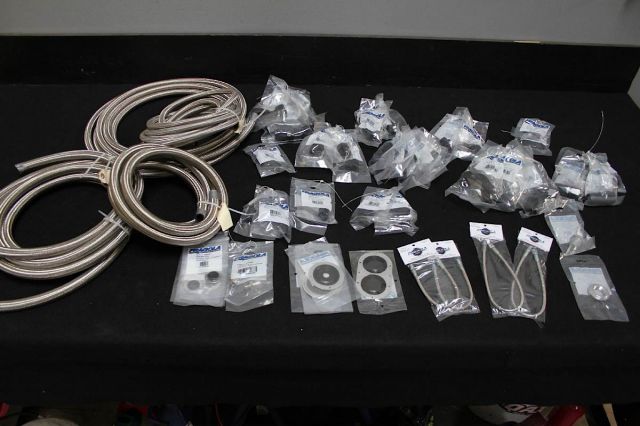 We’ve spent countless hours planning, installing and fine tuning every system on our max-effort drag car, Project BlownZ – and that is especially true for the engine systems. So far, our ProCharged 388ci LSX combo has produced over 1,100 horsepower at the rear wheels, and propelled us to low 8-second ETs in the quarter mile. But this thing is a hungry brute, feeding on a diet of race fuel and pressurized atmosphere. So in this installment we’ll discuss the robust fuel system we’ve employed to keep a steady supply of high-octane nourishment flowing into the belly of this LSX beast.
We’ve spent countless hours planning, installing and fine tuning every system on our max-effort drag car, Project BlownZ – and that is especially true for the engine systems. So far, our ProCharged 388ci LSX combo has produced over 1,100 horsepower at the rear wheels, and propelled us to low 8-second ETs in the quarter mile. But this thing is a hungry brute, feeding on a diet of race fuel and pressurized atmosphere. So in this installment we’ll discuss the robust fuel system we’ve employed to keep a steady supply of high-octane nourishment flowing into the belly of this LSX beast.
Ten years ago there weren’t all that many people making 1,200 to 1,500 horsepower with EFI – Jesse Powell, Aeromotive
The fuel system is one of those areas of a drag car that’s importance cannot be overstated, especially when you’re making the kind of power we are. “Ten years ago there weren’t all that many people making 1,200 to 1,500 horsepower with EFI. Now, it’s all too easy,” says Jesse Powell of Aeromotive. “If you are shooting for that kind of power, then you’d better make sure that you can supply enough fuel. You’ll always have to have more flow at operating pressure than the engine will need.”
To keep our 388ci LSX well fed, we went with the Pro Series fuel system components from Aeromotive and Series 3000 hose and fittings from Fragola Performance Systems. If you’ve been around motorsports for any length of time, there’s no doubt that you’re already familiar with both of these companies. Their components have been fueling championship winners in everything from off-roading, circle-track, and of course – drag racing.
Aeromotive EFI Pro-Series Fuel Pump
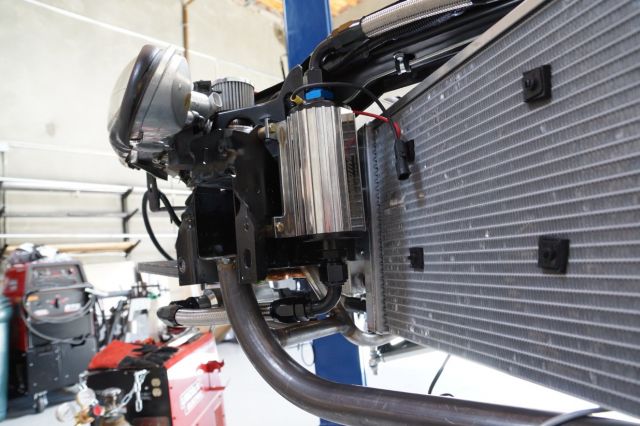
No inadequate fuel pressure or volume problems with this beast. The Aeromotive Pro Series EFI fuel pump can easily flow enough fuel to meet our 4-digit power goals, and even leave some room to grow.
Make no mistake, the fuel system centers around the pump. If it can’t keep up with the engine’s fueling demands, then essentially all our other efforts are for nothing. The nucleus of our fuel system is Aeromotive’s Pro Series EFI fuel pump (Part # 11102) – a fuel pump that is nothing short of an electronic cyclone wrapped in a shiny aluminum case. In fact, Aeromotive reports that this pump can flow enough fuel to safely support 1,700 forced induction EFI horsepower, and up to 2,600 naturally aspirated horsepower with a carburetor. For those of you keeping score, that is about double the flow capabilities of Aeromotive’s famous A1000 pump.
How does it achieve such outstanding flow numbers? The Pro Series EFI pump uses Aeromotive’s dual chamber pumping mechanism and a huge electrical motor. “The Pro Series are roller vane style pumps, and instead of having one pumping mechanism inside they have two, which allows for higher flow and higher pressures,” says Powell. “The basics of it are ‘pressure in, pressure out.’ The first pumping mechanism feeds the second one, allowing even more pressure and volume out of the second chamber.”
Obviously, we're not trying to give any illusions that BlownZ is a street car. But safety is still our number one priority, so we had our shop hands fabricate an NHRA compliant chomemoly barrier cage around the fuel and cooling systems up front
We mounted our Pro Series pump at the front of Project BlownZ behind the custom chromemoly cage we fabricated to protect the fuel and cooling systems. The pump is gravity fed from our custom built two-gallon fuel cell that’s mounted in front of the passenger side wheel well. Yes – the pump is mounted vertically. No – it doesn’t cause any negative effects. “The pump doesn’t care how you mount it – you can even submerse it in the tank if you wanted,” says Powell.
Pro Series EFI Fuel Pressure Regulator
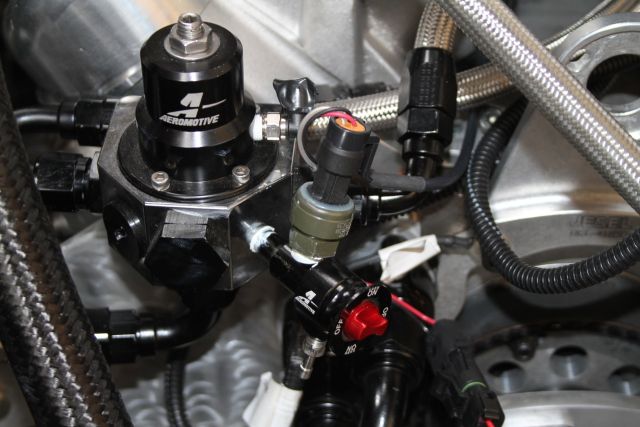
We’ve got a bit of extra gadgetry hanging off our Pro Series EFI FPR – the wiring from the fuel pressure sensor goes to the FAST XFI system, and the red valve is an Aeromotive fuel test port so the tech guys at the track can make sure we’re running the right gas for our class.
BlownZ’s Fuel System
- Aeromotive EFI Pro-Series Fuel Pump: Part # 11102
- Aeromotive Pro Series EFI Fuel Pressure Regulator: Part # 13110
- Aeromotive Pro Series EFI Fuel Filters: Part # 12302
- Holley LS Fuel Rails for Hi-Ram: Part # 534-203
- FAST 160-Pound fuel injectors: Part # 3016008
- Fragola Series 3000 Race Hose and Fittings
- Custom Built 2-Gallon Fuel Cell
To control that storm of fuel the pump will be trying to flood our 388 LSX with, we picked up the Aeromotive Pro Series EFI Fuel Pressure Regulator (FPR) (Part # 13110) to match the Pro Series pump. The Pro Series FPR is adjustable from 30 to 60 PSI, and uses vacuum and boost referencing for a 1:1 ratio of pressure increase – making it prefect for use with our big F1-R ProCharger. The Pro Series FPR has three outlets that offer flexibility in the size of lines and how they are oriented in the engine bay.
It might be easy to think that most aftermarket FPRs are created equal, but picking the wrong one could create a huge bottleneck and extremely inconsistent fuel pressure at the injectors. Powell tells us, “All regulators are of a similar design, with a spring and a diaphragm that references pressure. But each FPR needs to be matched to your fuel pump due to the volume of fuel that will be moved through the system. With the Pro Series fuel pump, you couldn’t use a regulator that’s any smaller than the Pro Series FPR because it just couldn’t handle the amount of flow. It simply couldn’t bypass the fuel fast enough to control the pressure, and would be too restrictive.”
Pro Series EFI Fuel Filters
Yes, fuel filters are still important on a drag car. There is simply no point risking our engine and all of our hard work because we didn’t use a filter. Best of all, if the right fuel filters are used, the fuel system will never even know they are there. Powell says, “We design every filter to match a specific fuel pump because we want the filter to be invisible to the pump. If there is more than a 1% drop in pressure anywhere in the system, it means that the filter is too restrictive. Any restriction in the system can cause damage to the fuel pump, and in turn the engine.”
We plumbed in a Pro Series Fuel Filter on each side of the fuel pump - one immediately after the fuel leaves the cell, and another before it goes on to the FPR. You might be thinking that the first filter is too close to the oil cooler, and will heat up the fuel. If his were a street car, we would agree. But the fuel will have plenty of time to cool down between rounds, so we aren't too worried about it, and it made the packaging much simpler up front.
We used a Pro Series EFI filter (Part # 12302) on each side of the fuel pump, both with 100 micron filter elements to sift out any junk before it makes its way to our injectors. An important consideration beyond the micron filter size is the surface size of the filter element. “Not all 100 micron filters are created equal,” says Powell. “You have to look at how much surface area the filter element has as well. Our filters have over 100 square inches of filtration media thanks to pleated elements.”
Fuel Rails and Injectors
We ran a line from two outlets on the Pro Series FPR to each of our Holley EFI Fuel Rails (Part # 534-203) to keep a steady flow of VP C16 heading to the massive 160 lb/hr FAST fuel injectors (Part # 3016008) on each bank of the engine at all times. Holley’s LS fuel rails are made of 100% billet aluminum, and are specifically designed for the Hi-Ram intake we are running.
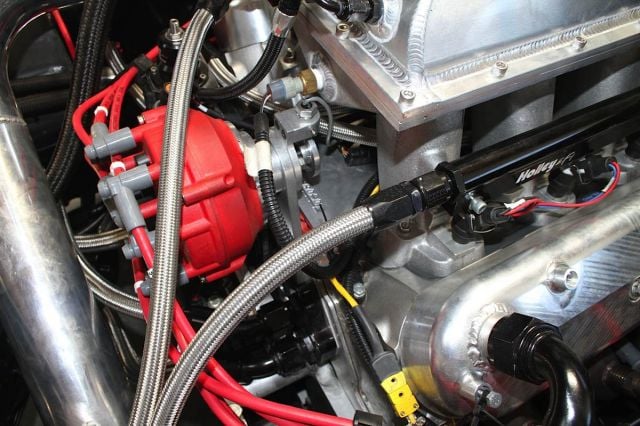
The fuel system finally terminates at the Holley Fuel Rails and gets atomized by 8 carefully calibrated and tested FAST 160 lb/hr injectors.
The FAST 160 lb/hr injectors are a great match for our fuel system and power goals. At a high brake specific fuel consumption number of around .65 for our ProCharged engine, these injectors should be able to support over 1,500 crank horsepower at a conservative 80% duty cycle. Perfect for the kind of power we are making, and they still leave us with room to grow if we decide to chase more even more power in the future. Powerful injectors need a powerful system to control them, and that’s exactly why we went with FAST’s XFI 2.0 (more on that in a future article).
Fragola Hose and Fittings
The importance of lines and fittings can't be overlooked. All the fittings from Fragola Performance Systems are 100% American made, so we know we can trust them to do their job safely and effectively.
Fragola Series 3000 Fuel Lines and Fittings
- -10AN x 90° Series 3000: Part # 109010-BL – Qty 2
- -10AN x 45° Series 3000: Part # 104510-BL – Qty 1
- -10AN Straight Series 3000: Part # 100110-BL – Qty 3
- 20 Feet of -10AN Series 3000 Hose: Part # 720010
- -8AN x 90°: Part # 109008-BL – Qty 8
- -8AN x 45°: Part # 104508-BL – Qty 4
- -8AN Straight Series 3000 Hose Fitting: Part # 100108-BL – Qty 2
- #8 x 3/4 -16 (8) Radius Fitting O-Ring: Part # 495103-BL – Qty 2
- 20 Feet of -8AN Series 3000 Hose: Part # 720008
To route the VP C16 from our fuel cell all the way to the fuel rails, we went with Fragola’s Series 3000 Race Hose in braided stainless and fittings in a combination of -12 AN, -10 AN, and -8 AN sizes (see the parts list to the right for everything we used.) The Series 3000 hose and fittings are designed to carry fuel, oil, and water at pressures of up to 1,500 PSI and temps of up to 300 degrees. They can handle just about any automotive fluid you might want to flow through them, and can take all the heat, pressure, and extreme vibration they are sure to see under the hood of BlownZ.
The Series 3000 hose ends are a cutter design that forms a seal by drawing the hose past the nipple and into the cutter. On the surface, Fragola’s fittings might seem similar to other -AN fittings you’ve seen, but the difference is on the inside. “Our Series 3000 hose ends are made of aerospace quality 6061 aluminum, and have a unique one-piece design that eliminates two brazed joints typically found in other hose ends,” says Fragola’s Jeff Stacy. Think about all the fittings in a fuel system like BlownZ’s, and that amounts to a whole lot fewer potential leaks. But the Series 3000 fittings don’t stop there. “These fittings also have two Viton O-rings that form a redundant seal to ensure a no-leak service,” Stacy adds.
Fragola's soft vice jaw holds the fittings just right, and made assembling our fuel hoses a snap.
As a bonus, putting all our fuel system plumbing together was simple and straightforward. Stacy tells us, “We designed our fittings with a wider wrench surface for a no slip installation, and a stainless steel lock wire prevents galling in the nut.”
With all our plumbing done, it was time to top off the fuel cell with VP C16, and get busy tuning on the dyno. We were rewarded with well over 1,100 horsepower at the rear wheels from our ProCharged 388 LSX.
Final Gear
Modern EFI fuel systems, especially those in race cars like BlownZ, are extremely unforgiving. Our ProCharged LSX needs a massive quantity of fuel delivered at the right pressures every single time we run it down the drag strip. We know there is no room for error, and that is precisely why we picked the fuel system components we did.
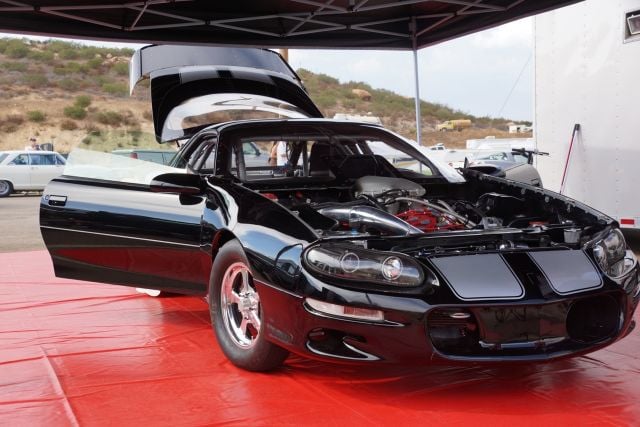
During our testing of BlownZ we were able to go as quick as 8.20 in the quarter, but we’re not done by a long shot. More power and more tuning are definitely in BlownZ’s future, and best of all – we won’t even have to upgrade the fuel system when we do bump up the boost.
Keep it tuned here for more updates on Project BlownZ, as we continue to chase down 7-second time slips!






